Inside The Makeen Program's Development Process
Program Story
Savola Group partnered with Kashida to build the Makeen online learning program, designed to increase awareness and capability around disability inclusion in the workplace. Using creative Learning Experience Design (LXD) techniques that blended storytelling, character-guided navigation, interactive environments, and scenario-based challenges, Kashida delivered a highly engaging experience that aligned with Savola World's strategic vision and supported Saudi Vision 2030.
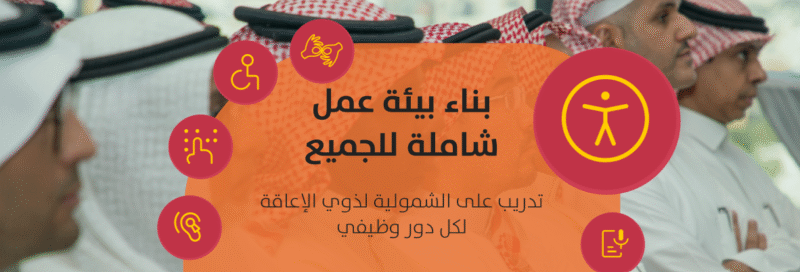
Client Context
Savola World Foundation leads several initiatives that empower people with disabilities and promote inclusion in the labour market. As part of this mandate and in alignment with Saudi Vision 2030, the Foundation sought to develop a training program that raises awareness around disability inclusion, builds practical skills for interacting effectively with colleagues with disabilities, and supports a wider cultural shift toward inclusive employment across Savola companies.
Why Creativity Matters In LXD And Design
Creativity in design is often underestimated, treated as a decorative "add-on." In reality, it is a core skill for both Learning Experience Designers (LXDs) and designers across disciplines. This was central to the development of the Makeen learning program.
For LXDs, creativity transforms learning from passive content delivery into immersive journeys that engage emotion, curiosity, and motivation. For designers, creativity ensures that products, visuals, and interfaces are not only functional but also usable, intuitive, and inspiring.
Creativity acts as the bridge between learning science (cognitive load, Bloom's taxonomy, AGES model) and engagement strategies (storytelling, gamification, visual design). In Makeen, this bridge connected complex concepts about inclusion to relatable workplace scenarios, enabling learners to progress confidently and stay motivated.
The Challenge: Beyond Content Delivery
Even strong courses can lose learners before completion. The challenge is rarely the subject itself, but rather how the learning is designed and experienced. This was particularly important in Makeen, where the content deals with sensitive and impactful aspects of workplace inclusion.
To succeed, the Kashida team had to avoid several common pitfalls:
- Monotony and lack of engagement. Traditional slides or long readings would not create the emotional connection needed for a topic as important as inclusion.
- Overwhelming or poorly structured content. Dense information and unclear sequencing can cause cognitive overload, especially on topics involving policies, workplace adjustments, and communication principles.
- Irrelevance to learners' context. If content does not reflect real situations, employees struggle to see its value, a risk when discussing workplace inclusion.
- Weak visual or interaction design. Outdated or cluttered design signals low value. Poor UI or UX, like confusing navigation or inconsistent layouts, frustrates learners and lowers trust.
- Absence of motivation drivers. When there are no rewards, recognition, or milestones, learners see little reason to continue. Progress feels invisible, and the course becomes a task instead of a challenge.
Our Solution: Creative Interventions In LXD And Design
The Kashida team used creative LXD, storytelling, realistic scenarios, and intuitive visual design to make the learning active and immersive. The key interventions included the following.
1. Storytelling And Characters
The team used storytelling and character guides, including employees represented with different disabilities, to make inclusion feel human, relatable, and emotionally engaging.
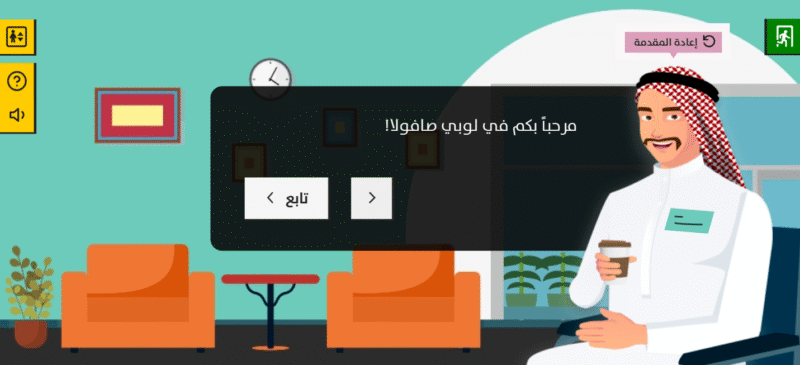
Image by Kashida
2. Visuals, Real Environments, And Structured Content
Complex topics were broken into visual, digestible segments. The Savola building served as the interactive environment, with an elevator that introduced a new topic on each floor, helping learners connect content to familiar workplace spaces.

Image by Kashida
3. Scenario-Based Learning
Short, realistic scenarios were placed at the start of each topic to activate prior knowledge and prompt learners to think before receiving the content. These scenarios mirrored everyday situations at Savola, helping learners recall what they already knew, build curiosity, and prepare for the upcoming learning points.
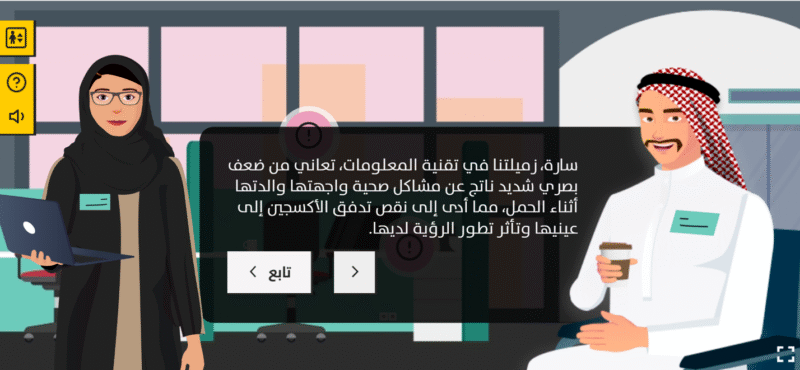
Image by Kashida
4. Modernize Visual And Interaction Design
The interface was kept clean, simple, and easy to navigate. Clickable hotspots, guided prompts, and minimal visual clutter reduced cognitive load, while soft ambient audio added subtle realism without distraction. This design approach helped learners stay focused and move confidently through each floor of the Savola building.
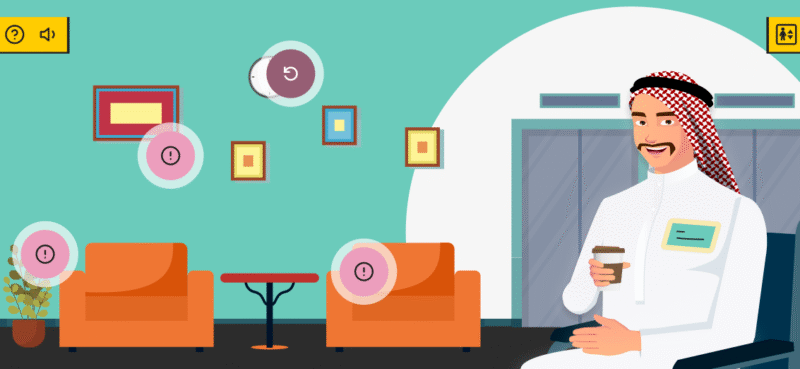
Image by Kashida
5. Motivate With Gamification
To maintain motivation throughout the journey, the Kashida team incorporated light gamification elements. Progress indicators, subtle sound cues, and small achievement moments that create a sense of advancement without feeling competitive or overwhelming. These elements helped learners recognize how far they had come, stay engaged through each floor of content, and feel a sense of accomplishment as they moved through the building.
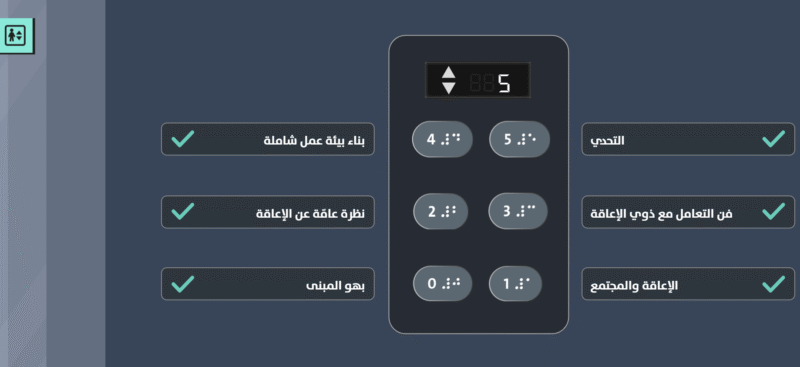
Image by Kashida
6. Accessibility By Design (WCAG 2.0 AA Compliance)
Accessibility was treated as a foundational design requirement. The Kashida team developed the learning experience in alignment with WCAG 2.0 AA standards, ensuring compliant color contrast, alternative text, keyboard accessibility, and clear content structuring. Given that Makeen focuses on disability inclusion, it was essential that the course itself reflect best practices in inclusive design, providing an equitable and fully accessible experience for all learners.
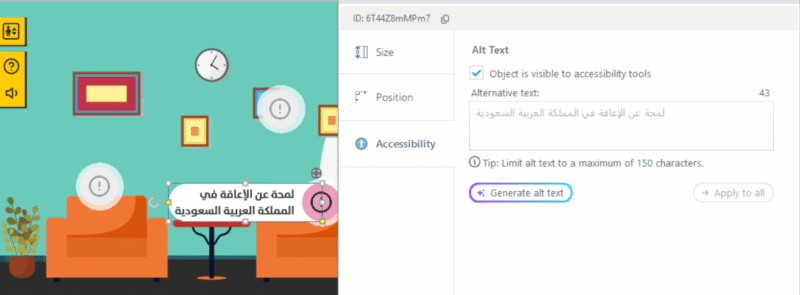
Image by Kashida
Expected Impact
The structure and creative strategies embedded in Makeen are designed to deliver measurable improvements in several areas.
1. Increased Employee Awareness
- Better understanding of disability inclusion concepts.
- Greater familiarity with real workplace accommodations.
2. Stronger Practical Skills
- Improved confidence in interacting with colleagues with disabilities.
- Enhanced ability to identify accessibility barriers and propose solutions.
3. Higher Engagement And Completion Rates
- Scenario-first design and interactive floors are expected to keep learners motivated.
- Gamification and narrative continuity support consistent participation.
4. Improved Learning Retention
- Storytelling and visual metaphors help learners recall information long after training.
5. Alignment With Vision 2030
- Promotes inclusive employment and supports national DEI commitments.
The Makeen online program is positioned to become a cornerstone of Savola World's inclusion efforts, enabling employees to translate training into daily inclusive behaviors.
Creativity As The Driving Force
Creativity and designing for impact were the foundation that transformed inclusion training into an active, memorable, and human-centered experience. By combining stories, realistic scenarios, interactive spaces, and simple gamification, the program helped employees understand and apply inclusive behaviors, supporting Savola's broader commitment to Vision 2030.
Read More:
- Learning Experience Design for Dummies
- Breaking Barriers: The Inclusive Design Checklist
- Putting People at the Heart of eLearning
- Makeen Mentors and Buddies Program



